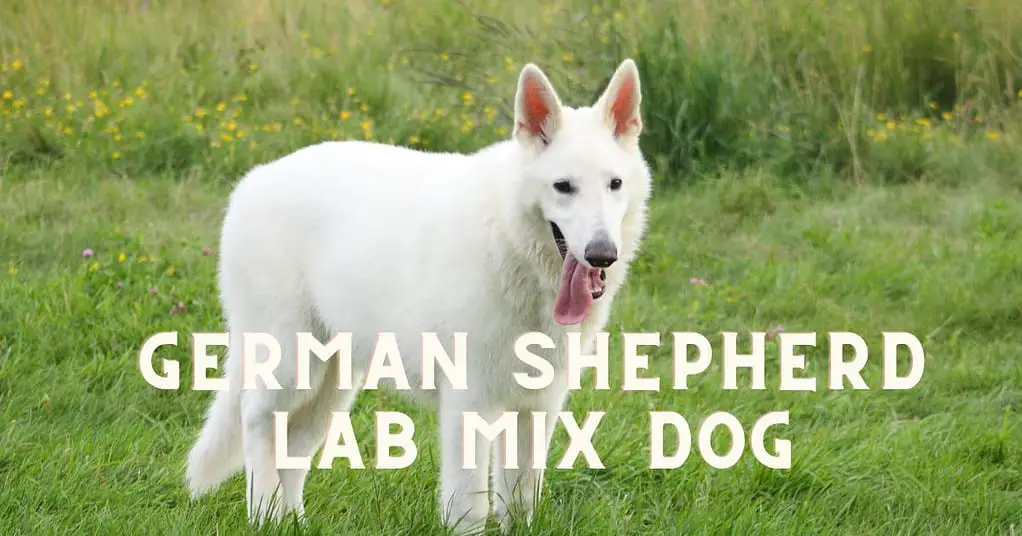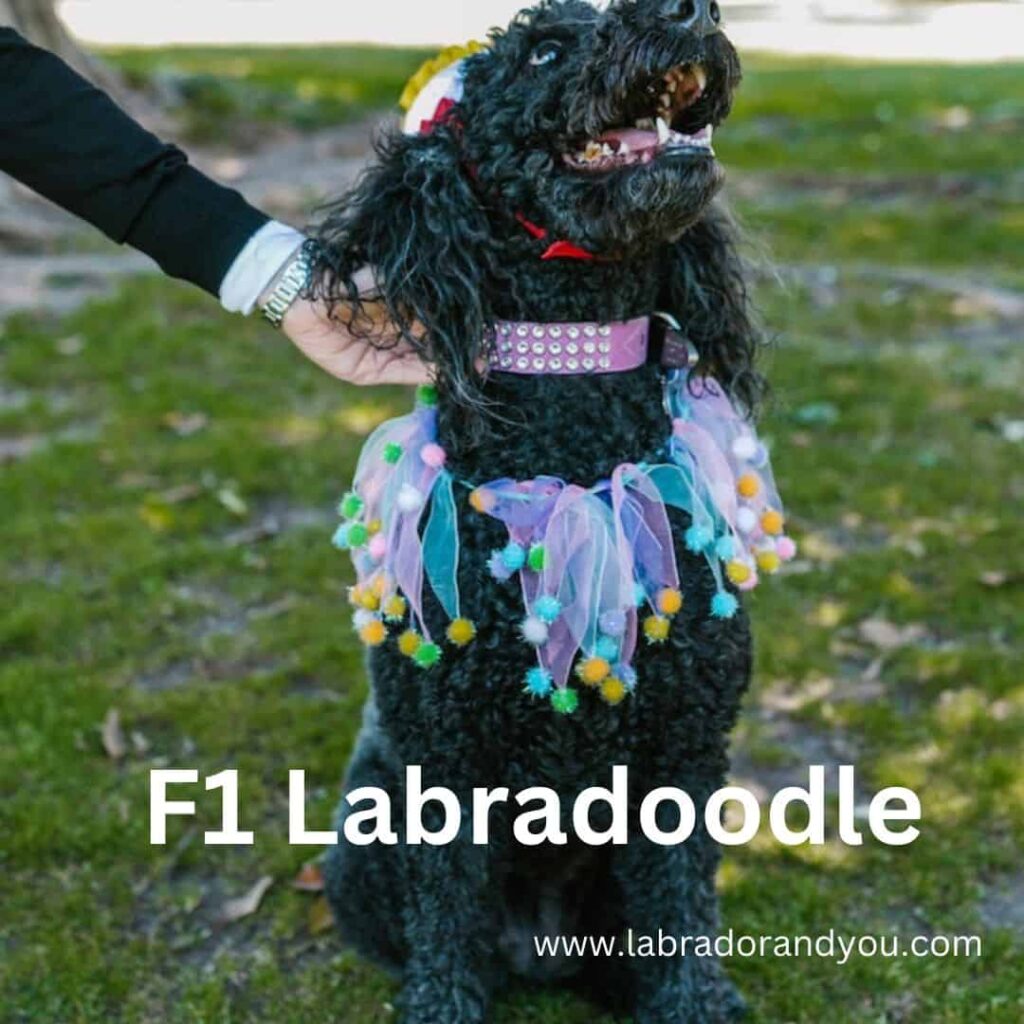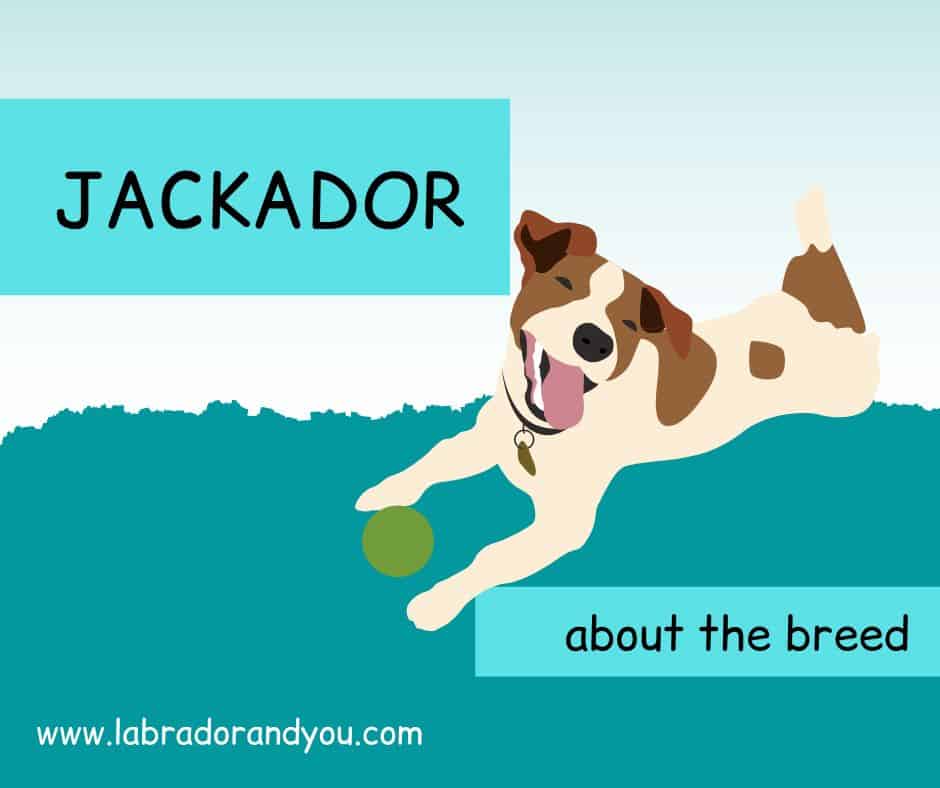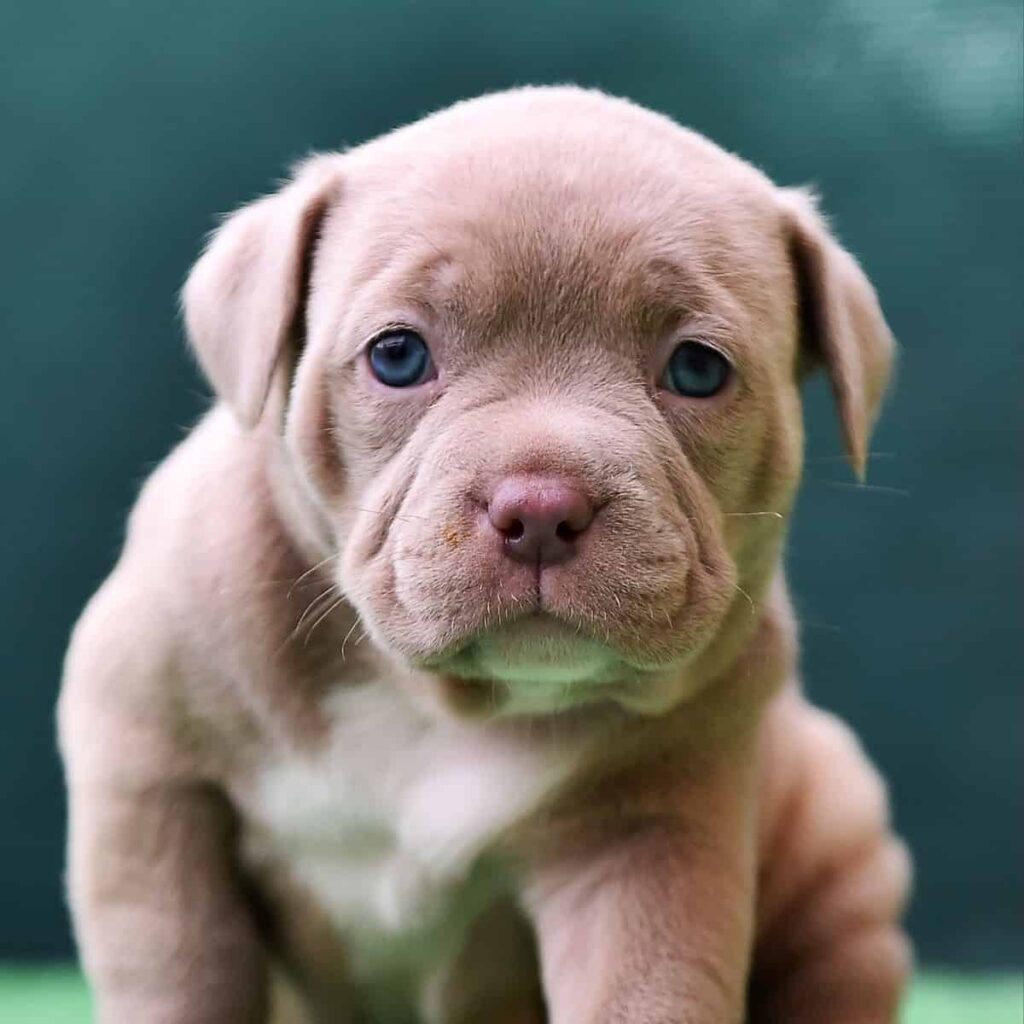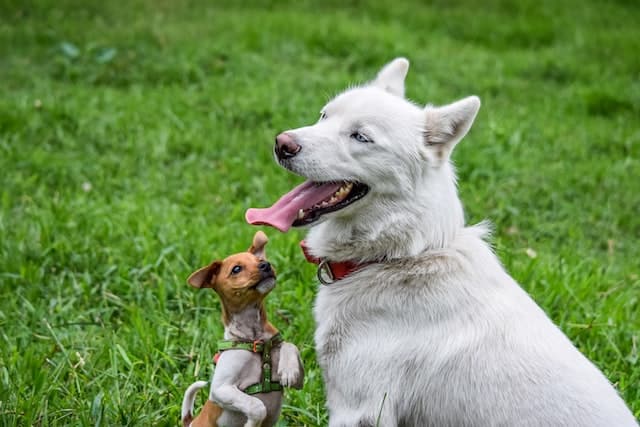F1b Labradoodle, in a nutshell, is a hybrid pooch with a little more Poodle in the mix. Born from a first-generation Labradoodle (F1) and a purebred Poodle, the F1B Labradoodle boasts 75% Poodle genes, giving it a hypoallergenic coat.
Having said that, remember, no dog is 100% hypoallergenic! These loving furballs come in various colors, from cream to chocolate and everything in between. Plus, their fun-loving, sociable nature fits into any family like a glove. But, on the flip side, they need plenty of exercise to prevent boredom and naughty behavior.
What Is A F1BB Generation Labradoodle?
An F1BB Labradoodle generation is a unique mixed breed dog that combines the best characteristics of the Poodle and Labrador Retriever. An F1B Labradoodle with 75% Poodle genetics is bred with a purebred Poodle parent to create this particular generation.
There is a high percentage of Poodle genetics in F1BB Labradoodles. They display more poodle-like traits than a standard first-generation Labradoodle or F1B labradoodle. This includes their coat types, like wavy or curly coats. They are ideal for allergic individuals due to their hypoallergenic qualities and non-shedding coat.
When adopting an F1BB Labradoodle pup, research their size (mini and standard), lifespan (generally around 12-15 years), temperament, etc. Their cost can differ depending on factors like breeder reputation and location.
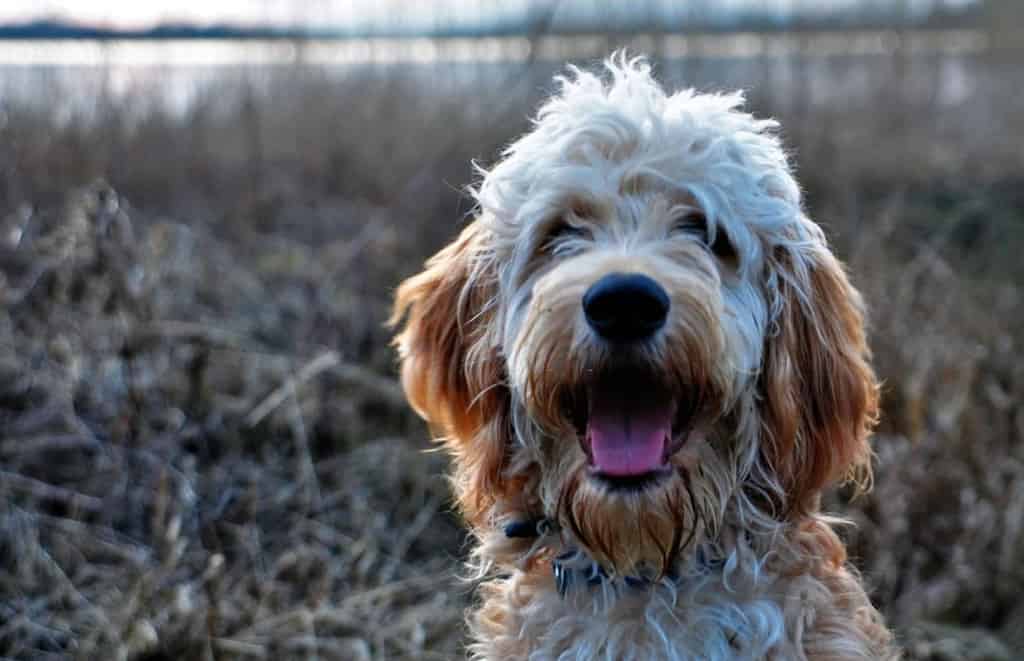
Why Do People Love F1B Labradoodles And Prefer To Breed Them?
F1B Labradoodles are a popular choice among dog owners and breeders. One of the primary factors fueling their popularity is their hypoallergenic coat. It results from the higher percentage of Poodle genetics. This characteristic makes them an ideal pet for allergy sufferers or those who prefer a nonshedding coat companion.
Besides their desirable coat type, F1B Labradoodles inherit many positive traits from both parents – purebred Labrador Retriever and Poodle. These attributes include high intelligence, loyalty, playfulness, and a friendly temperament toward children and other animals.
Another advantage is predictability in size and appearance compared to first-generation Labradoodle (F1). Breeders can control these elements when creating an F1B litter due to the increased presence of Poodle genes. Potential owners seeking a specific size may find locating one within an F1B generation easier than its predecessors.

F1B Labradoodle Size
F1B Labradoodles come in three different sizes: standard, medium, and mini or miniature poodle.
Standard F1B Labradoodle
Considered the largest among its counterparts, the Standard F1B Labradoodle has an imposing yet lovable appearance. This generation of Labradoodle boasts one Poodle purebred parent and one F1 Labradoodle parent. It makes them more poodle-like in terms of appearance and temperament.
They inherit desirable traits like low shedding coats and intelligence from their standard Poodle genes. However, they maintain the affectionate nature of a purebred labrador retriever.
Medium F1B Labradoodle
The medium F1B is a popular choice for many dog owners due to their size and temperament. These dogs weigh 30-50 pounds and stand around 18-20 inches tall. The medium F1B can have either wavy or curly hair with a fleece-like texture.
This coat is low shedding and allergy-friendly. These dogs require regular grooming to keep their coats healthy and matting-free.
Mini F1B Labradoodle
The Mini F1B Labradoodle is a small-sized, hypoallergenic dog. These mixed breed dogs are obtained by breeding an F1 Labradoodle with either a Mini Poodle or Labrador retriever.
One can also combine medium labradoodle puppies with miniature poodles to get a mini labradoodle.
The mini labradoodle is smaller than the standard poodles. They measure around 14-16 inches tall and weigh between 15 to 25 pounds. With wavy or curly coats that don’t shed much, individuals suffering from dog allergies often favor the mini labradoodle.
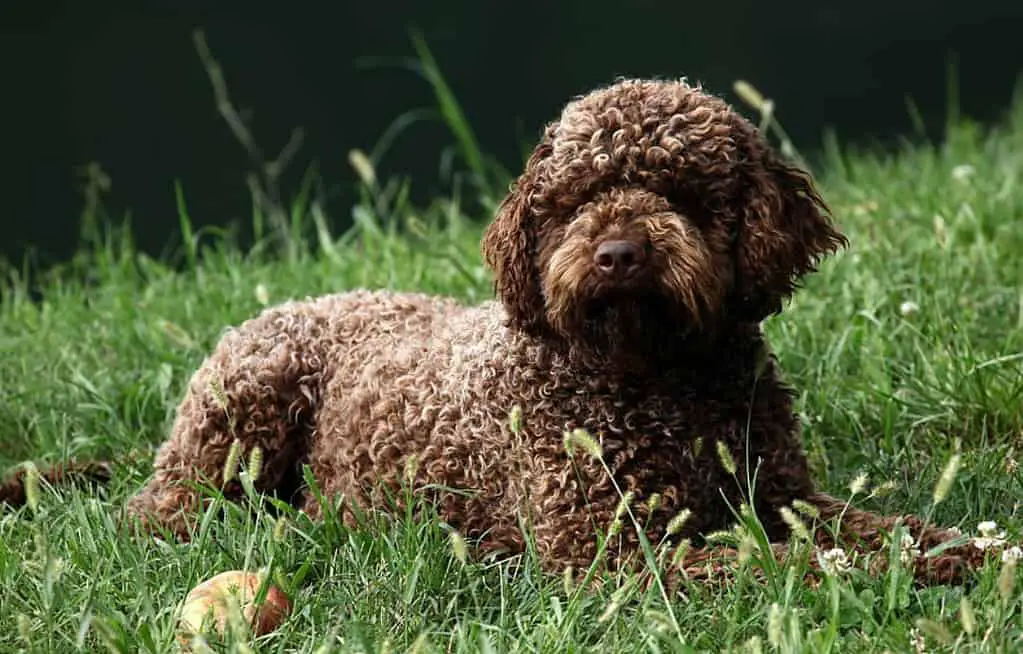
Various F1B Labradoodle Coats
F1B Labradoodles can have several coats influenced by their purebred parent dogs.
- Curly Coat: This coat type is often seen in dogs with a purebred Poodle parent. It has tight, curled hair and requires regular grooming to prevent matting.
- Wavy Coat: Breeding dogs with this coat type have hair that falls between curly and straight. They may have loose waves or curls but won’t be as tightly coiled as a curly-coated dog.
- Straight Coat: While not common in F1B Labradoodles, some dogs may inherit a straighter coat from one of their parent breeds. These hybrid dogs will still require regular grooming to maintain their coats.
Labradoodles come in various colors, like chocolate, black, red, merle, and white. Genetics determines the color of a dog’s fur passed down from its parents – Labrador retrievers or standard poodle parents.
Even though F1B Labradoodles are often bred for their hypoallergenic qualities, not all Labradoodles will be hypoallergenic. The texture of a dog’s hair and skin indicates whether or not someone with allergies will react to them.
F1b Labradoodle Colors And Temperament
F1b Labradoodles are sweet and affectionate, making them great family pets. Here are a few labradoodle generations based on color and temperament.
White F1b Labradoodle
The coat color of F1b Labradoodles can vary greatly depending on the parent’s genes. One popular color variation is the white F1b generation Labradoodle. It is bred by crossing an F1 Labradoodle with a purebred Poodle with a white coat.
These designer dogs have wavy or curly coats that are low-shedding and hypoallergenic. White F1b Labradoodles are known for their friendly personalities and obedience. They enjoy spending time with their owners and have gentle nature.
Red F1b Labradoodle
Red Labradoodles have a stunning appearance and friendly disposition. These dogs inherit their red coloring from their purebred Poodle parent. It can range from deep mahogany to light strawberry blonde. Red Labradoodles’ physical characteristics and temperament can vary depending on their generation (F1, F1b, F2, or F3).
F1b Red Labradoodles are known for being outgoing and affectionate. These great family pets enjoy spending time with people of all ages and are eager to please. These hypoallergenic dogs usually have a curly and low shedding coat.
Chocolate F1b Labradoodle
These pups have beautiful, rich brown coats that will turn heads at the dog park. They have energetic and playful personalities. They are great companions for families or active individuals who love outdoor activities.
While chocolate might be a desirable color in these designer dogs, it shouldn’t be the only factor considered when choosing a puppy. Breeders should prioritize health and temperament over appearance alone. Reputable breeders will offer health guarantees. Before selling their puppies, they will provide information about the parents of these mixed breeds.
Black F1b Labradoodle
The Black F1b generation Labradoodle is a popular and stunning color variation of the F1b breed. Their wavy or curly coat can range from jet black to charcoal gray. Regarding temperament, Black F1b Labradoodles are friendly, loving, and loyal companions. They are intelligent and easy to train due to their Labrador genes. They also have the Poodle’s natural obedience and alertness.
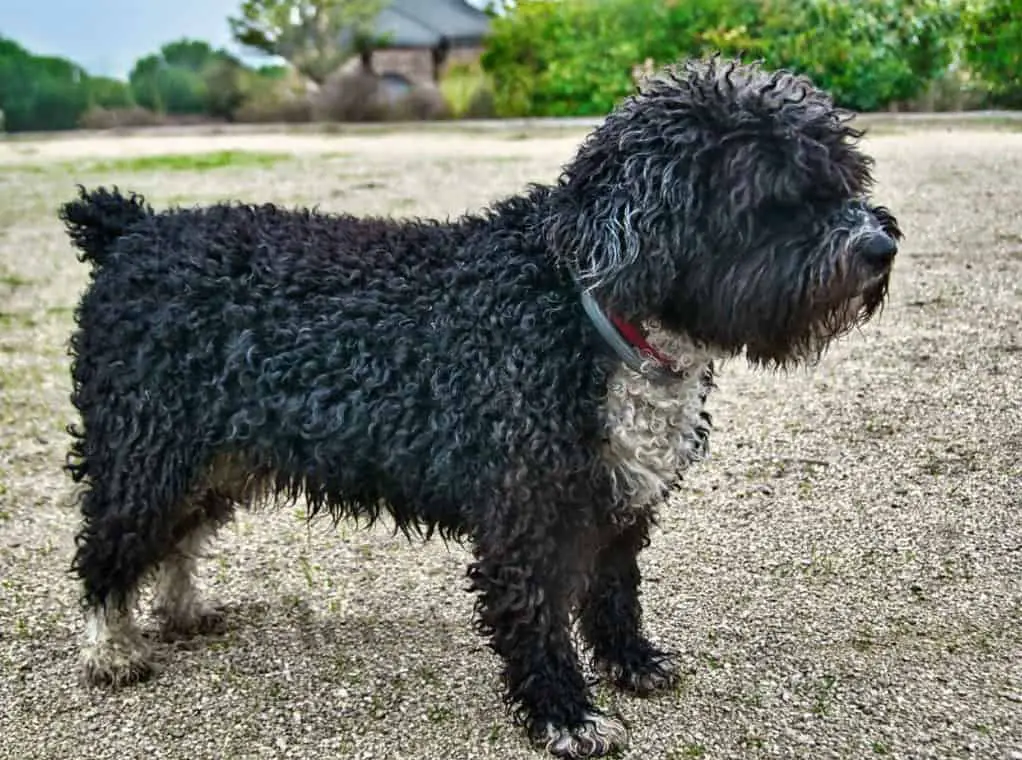
Merle F1b Labradoodle
With an additional Merle gene, Merle F1b Labradoodles cross between a Poodle and an F1 Labradoodle. This results in dogs with a striking coat pattern ranging from blue-grey to sable. Besides their stunning appearance, Merle F1b Labradoodles have friendly and trainable nature. They are intelligent and affectionate and make great companions for individuals or families.
How Much Should I Pay For An F1B Labradoodle?
The price of an F1B puppy largely depends on where you buy it from. When purchased from a reputable breeder, these adorable pups cost between $2000 to $4000.
These breeders ensure their dogs have proper medical care and maintenance, ensuring healthy puppies. Rescue shelters can be more affordable if you want to adopt a Labradoodle. The prices range from $50 to $500. The cost of owning a Labradoodle goes beyond just purchasing them. Vet care and supplies can add up quickly, costing anywhere from $1115 to $2650.
Caring For A Labradoodle
Caring for a Labradoodle isn’t too difficult but requires some effort. One of the first things to consider is grooming. Labradoodles need frequent brushing to keep their fur free from mats and tangles. A professional groomer can help with trimming and styling as well.
Choose a high-quality dog food that meets your Labradoodle’s nutritional needs. Regular vet check-ups are essential to ensuring good health and catching potential issues early on. Regular exercise, adequate nutrition, vet visits, early training, and socialization will keep them happy and healthy!
Training
Starting early on with socialization exercises. It will ensure that the dog grows up to be well-adjusted and friendly towards other animals and people.
Ensure that your Labradoodle gets plenty of exercise each day as they are active dogs by nature. Pet owners should be prepared to commit time and patience for their puppy to learn basic commands like sit, stay, come, and heel.
Doggy school or a professional trainer may also help get started with training exercises.
Grooming
These lovable dogs require weekly grooming maintenance, including nail clipping, ear cleaning, and brushing. Their curly hair can easily become knotted and matted if not properly groomed.
Labradoodles must visit a professional groomer every two to three months for a trim or haircut. Labradoodles with hairy coats will need to be brushed once a week. Those with fleece coats may only need brushing once every two weeks.
Spay & Neuter
Spaying or neutering your F1B Labradoodle is an important decision for every pet owner. The American Animal Hospital Association (AAHA) recommends spaying/neutering between 5-15 months of age. Labradoodles should wait until one year old before being neutered or spayed.
The decision to have your Labradoodle spayed/neutered will depend on factors like breed and sex. Some breeds, particularly larger ones like Labrador retriever and Poodle, are more prone to certain health problems. Joint issues are one example and can worsen if fixed too early.
Supplies
Before you bring home your new F1B Labradoodle, please ensure you have all the necessary supplies. Here is a checklist of essential items:
- Food and water bowls: Stainless steel or ceramic bowls are best for durability and hygiene.
- High-quality dog food: Consult your veterinarian to choose the right food for your puppy’s age, size, and activity level.
- Chew toys: Puppies love to chew. Provide a variety of safe and durable toys to prevent destructive behavior.
- Collar and leash: A well-fitting collar with identification tags and a sturdy leash will keep your puppy safe during walks.
- Bedding: A cozy bed or crate will give your puppy a comfortable resting place.
- Grooming supplies: A brush, shampoo, nail clippers, and ear cleaner will help maintain your puppy’s hygiene and appearance.
- Training tools: Treats, clicker, training pads, or litter box if you plan on doing indoor training.
- Vaccinations: Consult with your veterinarian on vaccines required for your area.
Harness
With their energetic and curious personalities, it’s essential to have control over them when walking or training. Several harnesses suit these dogs, but choosing the right one can be challenging. Labradoodles come in different sizes, from mini to standard, so not all harnesses will fit perfectly on every dog.
A properly fitted harness should not restrict movement or cause chafing on your dog’s skin. Professional groomers recommend getting a comfortable fit. Measure around your dog’s chest just behind its front legs and ensure enough room between the straps. Your pet’s body should not be too tight or loose.
Identification Tags
Identification tags should include the pet’s name, owner’s name, phone number, and address. You can always be careful when keeping your labradoodle safe and secure.
Plus, having an identification tag on your pet provides peace of mind. It ensures they can quickly reunite with you if they get lost or wander off in a public place.
Chew Toys
Chew toys are a must-have for a first-generation or second-generation labradoodle. Not only do they provide entertainment and relief from teething pain, but also prevent destructive chewing behavior.
Best chew toys for Labradoodles include beef tendons, lamb tripe sticks, and Himalayan Gold Yak dog chews. Durable options that won’t break easily or pose choking hazards are essential.
Vaccinations
Vaccinations are an important part of caring for your F1B puppy. The first round of vaccinations is typically given before picking up the new pup. Subsequent vaccinations ensure protection against deadly diseases such as parvo and distemper.
Puppies must receive three vaccinations by a licensed veterinarian before being considered fully vaccinated. While there may be controversy surrounding dog vaccinations, follow guidelines from reputable veterinarians.
Cleaning Ears
Keeping your F1B Labradoodle’s ears clean is important to avoid infections or ear problems. You’ll need cotton pads or buds and a gentle, dog-safe ear-cleaning solution to clean their ears.
Gently wipe away any dirt or debris in the outer ear with the cotton pad or bud. Do not push anything further into their ear canal, which can cause harm. See a vet if you notice excessive wax build-up, discharge, redness, swelling, or an unpleasant odor from your pooch’s ears.
Heart Worm
Heartworm disease is a serious health issue that can affect Labradoodle puppies. It’s often contracted through mosquito bites. The worms can grow 6-14 inches long in a dog’s heart. They pose serious health risks, leading to death if not treated in time.
As a responsible pet owner, use preventative measures like heartworm medication. Even indoor dogs are susceptible since mosquitoes can easily enter homes during warmer months.
Fleas & Ticks
As a Labradoodle owner, you want your furry friend to be healthy and happy. One way to ensure their well-being is by keeping them protected from fleas and ticks.
Many safe and effective flea and tick prevention products are available. Oral medications like NexGard or Bravecto can kill fleas and ticks for up to 12 weeks with only one dose.
Fleas infest weaker hosts and very young puppies or kittens with undeveloped immune systems. Always watch for any flea or tick activity on your Labradoodle puppy. More so if they spend time outdoors where these parasites are common.
F1b Labradoodle Haircuts
F1b Labradoodles require regular grooming and haircuts. Here are eight popular haircuts for this breed:
- Puppy cut – This simple, all-over clip keeps the coat short and low maintenance.
- Teddy bear cut – Similar to the puppy cut but with longer hair left on the face and legs. It gives an adorable, fluffy look.
- Kennel cut – A shorter version of the teddy bear cut. The hair is clipped close to the body for easy upkeep.
- Lion cut – Hair is left long on the head and neck while shaved close to the body, resembling a lion’s mane.
- Short cut – All hair is clipped very short for a low-maintenance style.
- Long cut – The coat is left longer overall, giving a flowing appearance.
- Modified schnauzer cut – Inspired by the standard schnauzer, this haircut features longer hair on top of the head and around the muzzle. The hair is closely clipped on the body.
- Topknot trim – The hair on top of the head is trimmed in a rounded shape. Longer strands are left around the ears and face.
F1b Vs F1 Labradoodle
When comparing F1 and F1B Labradoodles, understanding their differences can help you determine which type of Labradoodle is right for you. Here’s a helpful table that breaks down the differences between F1 and F1B Labradoodles:
| Characteristic | F1 Labradoodle | F1B Labradoodle |
| Genetic Makeup | 50% Poodle, 50% Labrador | 75% Poodle, 25% Labrador |
| Hypoallergenic | Less so than F1B | More so due to the higher Poodle percentage |
| Coat Type | Varies, but generally wavy or curly | Varies, but more curly and non-shedding |
| Popularity | Popular, but less so than F1B | Very popular, especially among allergy sufferers |
| Price | Generally less expensive | Generally more expensive due to demand |
FAQ
What Is More Hypoallergenic, A F1B Labradoodle Or A F1BB Labradoodle?
Both F1B and F1BB Labradoodles are hypoallergenic as they have a higher Poodle DNA. Because the F1B generation acquires more Poodle traits, it is slightly more hypoallergenic than the F1BB.
Is An F1B Australian Labradoodle Different To An F1B Labradoodle?
Both breeds result from breeding a poodle back to an F1 Labradoodle. The main difference is that the Australian labradoodle may also have other breeds mixed in. Both F1B Labradoodles generally have curly or wavy coats. Allergic people seek them due to their hypoallergenic qualities.
Will An F1B Labradoodle Cost More?
Yes, an F1B will typically cost more than other generations. This is due to their hypoallergenic qualities and increased demand. A Labradoodle puppy from a good breeder usually ranges from $1,500 to $2,000.
Why Are F1B Labradoodles Hypoallergenic?
F1B Labradoodles are considered hypoallergenic due to their Poodle genes. They have more Poodle parent DNA than first-generation Labradoodles. F1B Labradoodle is an allergy-friendly dog and has nonshedding coats.
What Kind Of Fur Will An F1B Labradoodle Have?
The purebred Poodle genes primarily determine the fur on an F1B Labradoodle. An F1B Labradoodle’s coat texture is expected to be wavy or curly. It is rare for an F1B Labradoodle to have a straight coat, but it can happen if they inherit more Labrador genes.
The texture of their coat may vary; some coats are tightly curled while others have looser waves. The fur on an F1B Labradoodle may or may not shed.
Are Male Or Female Labradoodles Better?
There isn’t a straightforward answer to whether male or female Labradoodles are better. It largely depends on the individual dog’s personality and characteristics. Some breeders argue that males are more affectionate and easier to train than females. However, others believe females have a calmer temperament and are less prone to territorial behavior.
Can An F1B Labradoodle Have Straight Hair?
It’s relatively uncommon for an F1b Labradoodle to have a straight shedding coat; it is still possible. Straight hair Labradoodles usually occur with an F1 or F2 Labradoodle. These generations have a 50% chance of inheriting a straight hair coat.
How Long Do F1b Labradoodles Live?
F1b Labradoodles typically have a lifespan of around 12 to 14 years. The longevity can vary based on their size and overall health. Standard Labradoodles may live closer to the lower range of the expected lifespan. Smaller varieties like mini or medium F1b Labradoodles could potentially live longer.
How Do I Find F1b Labradoodle Puppies For Sale Near Me?
To find F1b Labradoodle puppies for sale, check with local breeders specializing in labradoodles or poodles. You can also search online for reputable breeders. Another option is visiting adoption centers specializing in hybrid dog breeds like the F1b Labradoodle. These centers will often have puppies for adoption at a lower cost than purchasing one from a breeder.
Author Profile

- Product Reviews Specialist and Cofounder
-
Labradors have an extraordinary capacity for love and companionship, and my mission is to help you unlock their full potential. Hi there! I'm Sarah, a proud contributor to Labradorandyou, the go-to online resource for all Labrador Retriever enthusiasts. As a lifelong owner and avid admirer of these remarkable dogs, I bring a wealth of knowledge and hands-on experience to our readers.
One of my strongest beliefs is in the power of positive reinforcement training. I'm truly passionate about helping our readers build strong, positive relationships with their Labradors. Whether you're a first-time owner or a seasoned Labrador enthusiast, I aim to provide you with the resources and guidance to cultivate a bond that will endure a lifetime.
Also by the author
-
 Lab-TypesJuly 14, 2025
Lab-TypesJuly 14, 2025
-
 Lab-TypesJuly 13, 2025“стулочасы Зеркало На следующее В Бк 1xbet
Lab-TypesJuly 13, 2025“стулочасы Зеркало На следующее В Бк 1xbet
-
 Lab-TypesJuly 13, 2025“1xbet Официальный Сайт Регистрация И Вход а Личный Кабинет 1хбет
Lab-TypesJuly 13, 2025“1xbet Официальный Сайт Регистрация И Вход а Личный Кабинет 1хбет
-
 monobrendJuly 13, 2025“sg Καζίνο Στην Ελλάδα: Παίξτε Online Με Μπόνους Και Ασφαλή Τυχερά Παιχνίδια
monobrendJuly 13, 2025“sg Καζίνο Στην Ελλάδα: Παίξτε Online Με Μπόνους Και Ασφαλή Τυχερά Παιχνίδια
